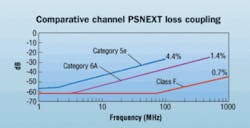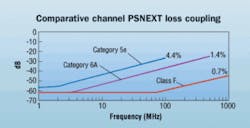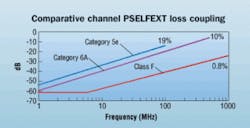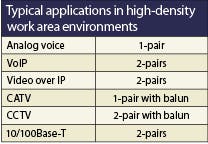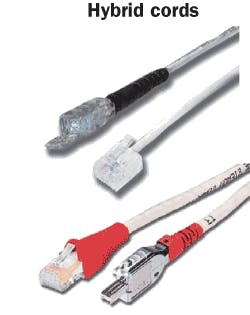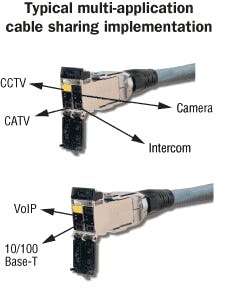In commercial buildings, cable sharing makes cents
This approach allows cost reduction, simplified cable management, and application convergence on twisted-pair media.
Although the concept of cable sharing is clearly accepted by telecommunications professionals, it is now only starting to become a recognized practice for reducing costs, simplifying cable management, and converging applications onto one media type in commercial building environments.
Cable sharing describes the practice of running more than one application over different pairs of a twisted-pair copper telecommunications channel. Common examples of cable sharing include transmitting twelve 10Base-T lines over a single 25-pair cable, and using Y-adapters to break out separate voice and fax lines transmitting over one channel behind the wall outlet.
The growing market acceptance of fully shielded (i.e., Category 7 or Class F) cabling systems has been identified as the primary reason why cable sharing techniques are appearing in the designs of the industry’s top IT infrastructure designers and consultants.
Telecommunications Industry Association (TIA) and International Organization for Standardization (ISO) telecommunications standards specify generic topologies and minimum recommendations to ensure consistent cabling system design throughout the world. In many commercial environments, the minimum standard requirement to provide two telecommunications outlets at each work area is adopted as the basic building infrastructure design. (Minimum telecommunications outlet requirements are specified in ANSI/TIA/EIA-568-B.2 and ISO/IEC 11801: 2002, 2nd edition.)
But some end users, such as call centers, fax centers, classrooms, training centers, and monitoring facilities, support significantly more than two applications at each work area. In fact, in health-care environments, some patient recovery room designs facilitate a minimum of 15 applications at each work area. Typical applications supported in these environments include two voice, four clinical Ethernet data, two intensive-care-unit remote patient monitoring Ethernet data, one nurse-call Ethernet, one auxiliary Ethernet data for non-clinical applications, two patient entertainment, and additional outlets for “family zone” activity.
These high-density work areas typically are supporting multiple low-speed applications in addition to one high-speed data service. Cable sharing strategies benefit these types of work areas by simplifying cable management through decreased cable count and reducing waste and cost by eliminating the unused pairs that would be present if a four-pair channel was dedicated to each application.
Further cost and cable-management benefits can be realized if such services as CATV and CCTV, which typically transmit over coaxial cable, and intercom, which transmits over 18-AWG copper wires, are converged onto the telecommunications network using low-cost devices, such as video baluns.
Standard recognition
Some designers and consultants are concerned about specifying cable sharing because they are unsure of the standards’ acceptance of the practice. The good news is that both the TIA and ISO recognize and provide guidance on cable sharing implementation.
Annex B of ANSI/TIA/EIA-568-B.1 describes the transmission performance of various types of applications that do not interfere with each other in a shared environment based upon the internal crosstalk found in unshielded twisted-pair (UTP) cabling systems, and provides examples of applications that can coexist in multi-pair cables. The standard also indicates that knowledge of an application’s transmission type (i.e., bursty, continuous, synchronized, or random) and the internal noise of the cabling plant can be used to make a determination as to whether multiple applications or appearances of the same application can coexist in one channel.
The ISO/IEC 11801: 2002, 2nd Edition standard expands on this information and provides crosstalk considerations for cable sharing, as well as guidance for minimizing sheath-sharing incompatibilities. The ISO/IEC 15018 standard goes one step further and recommends that cable sharing may be considered when pathway space is limited in residential environments.
Industry groups, such as BICSI, and building codes, such as the National Electrical Code (NEC) in the United States, accept the practice of cable sharing. In summary, all telecommunications standards recognize cable sharing and provide implementation guidance based upon the potential for application interference due to the internal crosstalk levels of the cabling channel.
Cable sharing did not start gaining in popularity until the ISO standard’s adoption of Class F fully shielded cabling systems. This is because the amount of internal crosstalk coupling (both near-end and far-end) in UTP and F/UTP (foil over twisted-pair) cabling systems made it difficult for users to predict whether multiple applications could coexist in one cable.
Calculations demonstrate that 23.4% of an application’s transmitted signal appears as either power-sum near-end or far-end crosstalk noise at 100 MHz in Category 5e/Class D cabling systems. The situation improves for Category 6A/Class EAsystems, with 11.4% of an application’s transmitted signal appearing as either power-sum near-end or far-end crosstalk noise at 100 MHz; but this performance is not sufficient to ensure that all applications will perform properly in a shared sheath environment.
With only 1.6% of an application’s transmitted signal appearing as either power-sum near-end or far-end crosstalk noise at 100 MHz in Class F cabling systems, end users are guaranteed that there is sufficient noise isolation between pairs to support multiple applications or the multiple appearance of any one application over a four-pair Class F channel.
Class F and beyond
Class F cabling requirements initially appeared in the first edition of the ISO/IEC 11801 standard. published in 1999. Class F cabling is constructed from fully shielded Category 7 components and is characterized to a bandwidth of 1 to 600 MHz. The preferred connecting hardware interface for cable sharing implementations is the non-RJ-style interface described in IEC 61073-3-104. The isolated quadrant design of the non-RJ-style interface allows easy access to one or two pairs of the channel using one- and two-pair non-RJ-style plugs terminated to the appropriately wired RJ-45 or RJ-11 Ethernet plug.
Class FA cabling requirements are under development by ISO and, using the same non-RJ-style connector mated to an enhanced Category 7Acable, are characterized over the bandwidth of 1 to 1,000 MHz. Class FA is the appropriate grade of cabling to specify to support all channels of CATV (up to 862 MHz).
Although cable sharing implementation practices are extremely flexible and support a wide range of configurations, two basic configurations can satisfy the needs of most end users. In call and fax centers, agents typically are arranged in work groups and are supported by an analog phone and Internet connection. In this example, the recommended cable sharing practice would be to provide each work group of four agents with a multi-user telecommunications outlet assembly (MUTOA) containing one Class F outlet and four Category 6A outlets.
The one Class F channel would provide four analog phone lines to the group. By using cable sharing practices in call and fax centers, end users typically realize a cost savings in excess of 10% for materials, a 38% reduction in the total number of outlets, and reduced cable-management complexity.
In many multi-application environments, such as classrooms, health care, and monitoring facilities, work area outlets support a plethora of services, including Voice over IP (VoIP), CATV, CCTV, Internet, security cameras, intercom, and high-speed data. In this example, providing a dedicated cable for each application would require nine outlets at the work area.
A more efficient solution for multi-application environments is to implement cable sharing, whereby each work area would support the nine services over two Class F channels and one Category 6A channel. The two Class F outlets would support CCTV, CATV, security camera, intercom, VoIP, and 10/100Base-T.
Using this implementation, end users typically realize a cost savings in excess of 20% for materials, a 57% reduction in the number of outlets, and reduced cable management complexity. In addition, end users benefit from converging their coaxial (CATV and CCTV) and copper wiring (intercom) onto the telecommunications network for the added benefit of simplified infrastructure management and reduced complexity.
When designing cable sharing solutions, it is critical to plan for the types of applications to be supported and understand their equipment lifecycles. Fortunately, the lifecycle of call center and most video applications is greater than the 10-year lifecycle specified by the TIA and ISO standards for data applications.
Minimum essentials
Although there are many benefits to be realized from implementing cable sharing design strategies, it is important to remember that these techniques can reduce the ability of the cabling infrastructure to support future applications and upgrades. As a result, the recommended practice for all cable sharing solutions is to provide a minimum of one dedicated four-pair Category 6A or higher rated outlet in addition to the shared Class F outlets to ensure a migration path for high-speed data upgrades.
End user demand for high-density, low-speed application support is increasing as more equipment devices support Internet Protocol, Ethernet communication, and operation over twisted-pair cabling. Class F and FA cabling, however, provide the necessary internal noise isolation to support standards-approved cable sharing methods that reduce cost, simplify cable management, and support convergence of applications on twisted-pair media.VALERIE RYBINSKI is global sales engineer with The Siemon Company (www.siemon.com).
